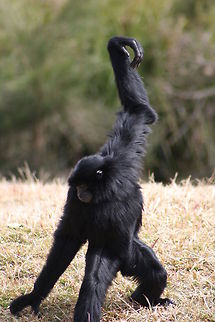
Appearance
The siamang has long, dense, shaggy hair which is the darkest shade of all gibbons. The ape has long, gangling arms that are longer than their legs. The average length of a siamang is 90cm, but the largest they have ever grown is 1 meter 50 cm. The face of this large gibbon is mostly hairless apart from a thin mustache.The siamang is distinctive for two reasons. The first is that two digits on each foot are partially joined by a membrane—hence the name "syndactylus", from the Ancient Greek "sun-", "united" + "daktulos", "finger". The second is the large gular sac, which is a throat pouch that can be inflated to the size of the siamang's head, allowing the animal to make loud, resonating calls or songs.
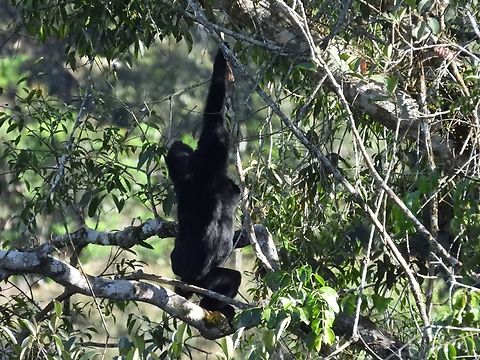
Naming
There may be two subspecies of the siamang. If so, they are the nominate Sumatran siamang and the Malaysian siamang. Otherwise, the Malaysian individuals are only a population. The siamang occurs sympatrically with other gibbons; its two ranges are entirely within the combined ranges of the agile gibbon and the lar gibbon. Although the siamang is given a name different from that of other gibbons, this division is not cladistically sound, since the genus "Nomascus" split from the rest of the gibbons before the "Symphalangus" split.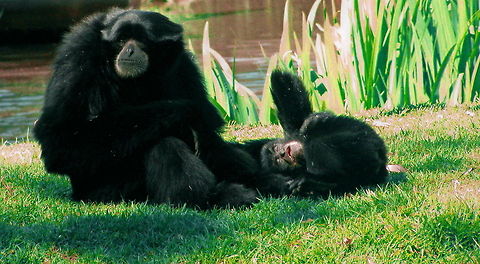
Status
The siamang, as an arboreal primate, absolutely depends on the forest for existence, so is facing a population decrease due to habitat loss, poaching and hunting.The siamang is known to occur in at least ten protected areas: Kerinci Seblat National Park, Bukit Barisan Selatan National Park, Gunung Leuser National Park, Way Kambas National Park and West Langkat Reserve in Indonesia, Fraser's Hill Reserve, Gunong Besout Forest Reserve, Krau Wildlife Reserve and Ulu Gombak Wildlife Reserve in Malaysia and the Hala Bala Wildlife Sanctuary in Thailand.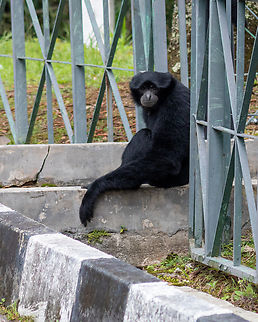
Behavior
The siamang tends to rest for more than 50% of its waking period, followed by feeding, moving, foraging and social activities. It takes more rest during midday, taking time to groom others or play. During resting time, it usually uses a branch of a large tree, lying on its back or stomach. Feeding behaviors, foraging, and moving are most often in the morning and after resting time. Grooming is one of the most important social interactions among family members. Grooming takes place between the adults earlier in the day, and then the adults groom the juveniles later in the day. Adult males are the most involved in grooming.In the dry season, the size of the siamang's daily range is larger than in the rainy season. The siamang in southern Sumatra undertakes less foraging than the siamang in other places because it eats more fruit and therefore consumes more nutrients, which results in less time needed for looking for food. Sometimes, the siamang will spend all of the day in one big fruiting tree, just moving out when it wants to rest and then coming back again to fruiting trees.
Siamangs are a very social species of primates and exhibit a variety of tactile and visual gestures, along with actions and facial expressions to communicate and increase social bonds within their family group. Siamangs are also territorial and interact with other family groups by making loud calls to let other groups know where their territory is. The calls may be asynchronous, where they are not directed at a particular neighboring group, or simultaneous group calls may take place across the territory boundary. In addition, males will chase each other across the boundary.
Grooming frequency between males and females has been found to correlate to copulation frequency, as well as bouts of aggression. Pairs copulate during four to five months at intervals of two to three years. The peak of their reproductive activity is often during the time when fruit is most abundant. Dorsoventral copulation is the most common type of copulation in siamangs, where the female is squatting and the male hangs by his arms and grips the female with his legs, whereas ventroventral copulation, where both primates are suspended, occurs only one in 60 times on average.
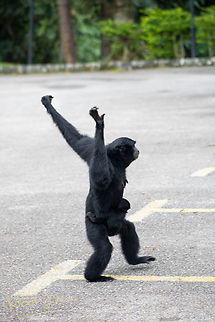
Habitat
The siamang inhabits the forest remnants of Sumatra Island and the Malay Peninsula, and is widely distributed from lowland forest to montane forest—even a rainforest—and can be found at altitudes of up to 3800 m. The siamang lives in groups of up to six individuals with an average home range of 23 hectares. Their day ranges are substantially smaller than those of sympatric "Hylobates" species, often less than 1 km. The siamang's melodious singing breaks the forest's silence in the early morning after the agile gibbons' or lar gibbons' calls. The siamang in Sumatra and the Malay Peninsula are similar in appearance, but some behaviors differ between the two populations.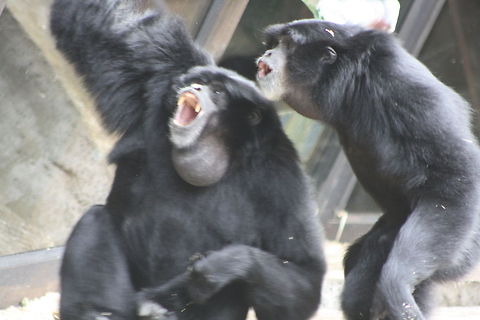
Food
The siamang eats mainly various parts of plants. The Sumatran siamang is more frugivorous than its Malayan relative, with fruit making up to 60% of its diet. The siamang eats at least 160 species of plants, from vines to woody plants. Its major food is figs, a member of the Moraceae family. The siamang prefers to eat ripe rather than unripe fruit, and young rather than old leaves. It eats flowers and a few animals, mostly insects. When the siamang eats large flowers, it eats only the corollae, but it will eat all parts of smaller flowers, with the small fruit collected in its hand before being consumed. When it eats big and hard seeds or seeds with sharp edges, it will peel out the fruit flesh and throw away the seed. Although its diet consists of substantial portions of fruit, it is the most folivorous of all members of Hylobatidae. As it is also the largest gibbon, it fits well with the general primate dietary trend in which larger primates tend to be more folivorous.Unlike other parts of Asia, primates are not hunted for their meat in Indonesia. They are poached and hunted for the illegal pet trade, mostly for infant siamangs. Poachers often kill the mothers first, since siamang females are highly protective of their infants, and it is difficult to remove the infant without first killing the mother. Most siamangs on the market are infants, which often die during transportation.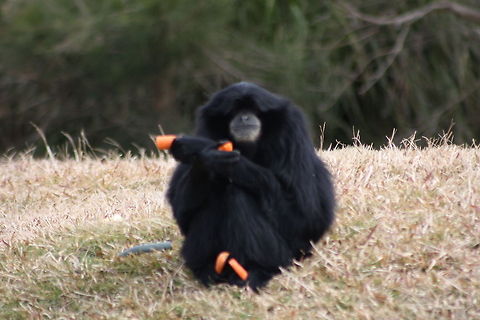
Predators
The siamang, as an arboreal primate, absolutely depends on the forest for existence, so is facing a population decrease due to habitat loss, poaching and hunting.References:
Some text fragments are auto parsed from Wikipedia.